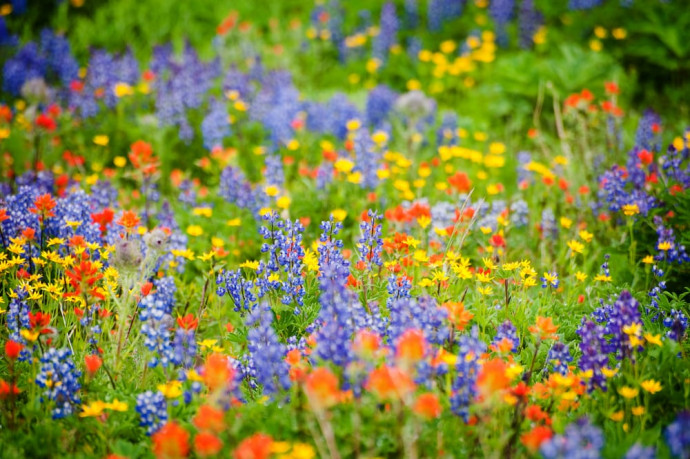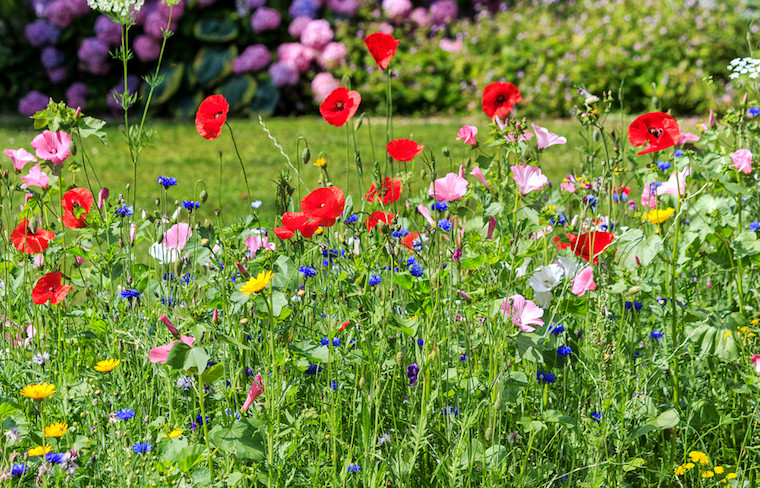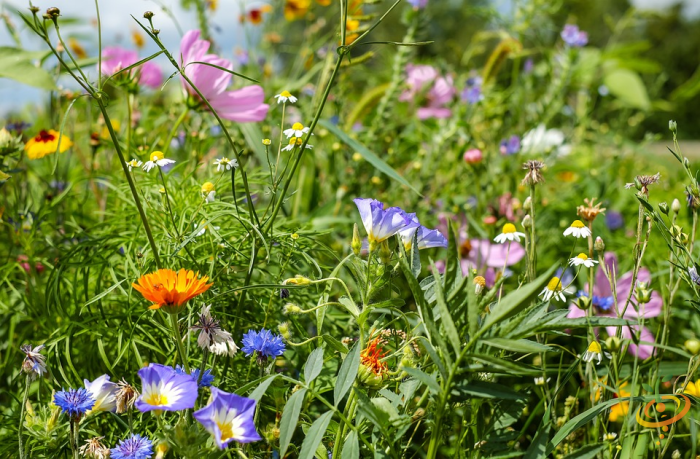Growing Wildflowers from Seed

Wild flowers are really wonderful materials for the gardener, especially the mixtures that can be grown from seed. They are usually labeled by climate or geographical area and contain from 6 to 12 different species of flowers. Many such mixes are available in catalogs and garden centers.
Wildflower seeds can be scattered on the ground, but it is best to do nature a favor and rake them in lightly to provide some protection from wind and rain. For better results, till the soil and cover the tiny seeds with a thin layer of peat moss. Keep the seeds moist for about six weeks.
On steep slopes where moisture is difficult to maintain, sow the seeds in a top layer of very coarse gravel or lava rock. The seeds will sprout between these materials, which will help keep the soil moist and keep the small seedlings in place so their roots have a chance to take hold.

Temperature
Most wildflowers germinate easily in a temperature range of 60°-75°F. Higher temperatures can be harmful to some species. This temperature sensitivity is nature's way of preventing seeds from germinating during hot, dry periods when it would be difficult for seedlings to survive.
Plant hardy perennials in spring or fall for best results. Seeds should be planted in a sheltered spot to minimize the risk of being washed or blown away. Plant late enough in the fall to ensure that germination does not occur until the following spring, or early enough so that the seedlings are well established before the first frost. Plant in the spring after the danger of frost has passed. If possible, get the seed into the ground before a rain, or water the seeds so they have enough moisture to germinate.
Dormancy
Seeds that do not germinate under favorable conditions are called dormant. This state of dormancy is not accidental; plants survive in nature because of certain built-in timing mechanisms that delay germination until the seedlings have the best chance of survival.
Some seeds do not germinate when exposed to cold temperatures. This causes a delay in germination, usually until spring when precipitation and other conditions in the environment are favorable. Wildflowers that have a "cold dormancy" period can be planted outdoors in late fall or treated by a process called "moist-chilling," in which the seeds are overwintered in the refrigerator for one to three months. Here's how this is accomplished:
Soak seeds that respond to moist chilling in water at room temperature for 12 to 24 hours. Then mix them with a sterile, moistened medium such as sphagnum peat, vermiculite or sand. Place the medium in a plastic bag or similar container that is not airtight. Store it in the refrigerator at 40° to 50°F, not in the freezer, for three to six weeks. Keep the medium moist, but not wet. When the refrigeration period is complete, sow the seeds immediately at relatively cool temperatures.
Seeds that require only three to four weeks of moist refrigeration can be germinated in a greenhouse when nighttime temperatures are in the 40°-50°F range.
If such treatment is necessary, it is usually indicated on the package. Most wildflower seeds do not require such cold exposure and will germinate without special treatment.
Mass Sowing
If you want to do mass plantings of wildflowers, there is an easy way to get good results:
Till the soil to a depth of six to eight inches. The seedbed should have a loose, crumbly texture and good drainage. You can improve the air and water holding capacity of the soil by mixing in peat moss or other available organic material. Spread the seeds evenly and cover them with a thin layer (no more than ¼ inch) of peat moss. If peat moss is not used as the top layer, lightly rake the seeds into the soil. If a few seeds are not completely covered, don't worry; it's best if the seeds are not planted deep.
Use a fine spray of water to thoroughly moisten the soil. Keep the seeds evenly moist for four to six weeks; after that, watering can be gradually reduced.
You can also sow the seeds in a single layer of coarse gravel or lava rock (1- to 1½-inch size). This is a good way to plant on steep slopes or areas that are difficult to keep moist. The seeds that germinate in the cracks and crevices come in contact with moist soil and are also protected from the elements. If natural precipitation is the only source of moisture, plant seeds in the spring just before expected periods of rain.

Dry areas
If you plan to plant in a dry area, buy a mix of annuals, biennials and perennials, most of which will sprout in 10 to 21 days at a temperature of 55°-70°F. While such a mix is best suited to dry climates, most flowers adapt to moist climates in sandy, well-drained soil. Perennials will survive cold winters in northern climates. Such a mix might contain baby’s breath, chicory, coneflower, cornflower, wild blue flax, gaillardia, penstemon, poor-man’s-weatherglass, California poppy, prairie aster, and yarrow.
Moist Climates
The following mixture is best suited for moist climates, but will survive in dry climates if watered regularly. Recommended are baby blue-eyes, columbine, coreopsis, dame’s rocket, larkspur, ox-eye daisy, scarlet flax, and wallflower. These perennials will survive cold winter climates. In mountainous regions above 8,500 feet elevation, there is usually ample moisture for this mix.
